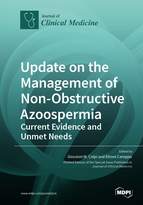Update on the Management of Non-Obstructive Azoospermia: Current Evidence and Unmet Needs
A special issue of Journal of Clinical Medicine (ISSN 2077-0383). This special issue belongs to the section "Reproductive Medicine & Andrology".
Deadline for manuscript submissions: closed (30 June 2021) | Viewed by 55136
Special Issue Editors
Interests: azoospermia (non-obstructive and obstructive); surgical sperm retrieval for ICSI; epididymis pathology in male infertility; seminal tract surgery; severe male infertility (all kinds); sperm DNA fragmentation in clinical practice; varicocele
Special Issues, Collections and Topics in MDPI journals
Interests: male infertility; non-obstructive azoospermia; hormonal treatment of male infertility; epigenetic factors; infertility
Special Issues, Collections and Topics in MDPI journals
Special Issue Information
Dear colleagues,
Azoospermia affects about 1% of male population and up to 15% of infertile male subjects. In most azoospermic patients, the absence of sperm in the ejaculate is due to spermatogenic dysfunction (the so-called non-obstructive azoospermia - NOA); since these patients may be still able to father their own genetically children if viable sperm are found in their testes, much effort have been spent in order to individuate the best surgical technique to retrieve testicular sperm, the most reliable predictive factors of successful sperm retrieval, and the optimal management of these patients. Although there is great consensus about the role of microdissection testicular sperm extraction (microTESE) as the gold standard surgical technique to retrieve testicular sperm in patients with NOA, conventional TESE is still being used in many IVF centres, although this may significantly limit the reproductive chances of these patients.
In this Special Issue, we will publish reviews and original research that provide new insights into the management of patients with NOA. Articles about the surgical approach to sperm retrieval and the hormonal treatment of patients with NOA will be particularly welcome.
Prof. Dr. Giovanni M. Colpi
Dr. Ettore Caroppo
Guest Editors
Manuscript Submission Information
Manuscripts should be submitted online at www.mdpi.com by registering and logging in to this website. Once you are registered, click here to go to the submission form. Manuscripts can be submitted until the deadline. All submissions that pass pre-check are peer-reviewed. Accepted papers will be published continuously in the journal (as soon as accepted) and will be listed together on the special issue website. Research articles, review articles as well as short communications are invited. For planned papers, a title and short abstract (about 100 words) can be sent to the Editorial Office for announcement on this website.
Submitted manuscripts should not have been published previously, nor be under consideration for publication elsewhere (except conference proceedings papers). All manuscripts are thoroughly refereed through a single-blind peer-review process. A guide for authors and other relevant information for submission of manuscripts is available on the Instructions for Authors page. Journal of Clinical Medicine is an international peer-reviewed open access semimonthly journal published by MDPI.
Please visit the Instructions for Authors page before submitting a manuscript. The Article Processing Charge (APC) for publication in this open access journal is 2600 CHF (Swiss Francs). Submitted papers should be well formatted and use good English. Authors may use MDPI's English editing service prior to publication or during author revisions.
Keywords
- Differential diagnosis of azoospermia
- Prediction of sperm retrieval
- MicroTESE vs TESE
- Testis histology
- Hormonal treatment of men with NOA
- Sperm retrieval in Klinefelter patients
- New methods to improve the sperm yield from testicular specimens








